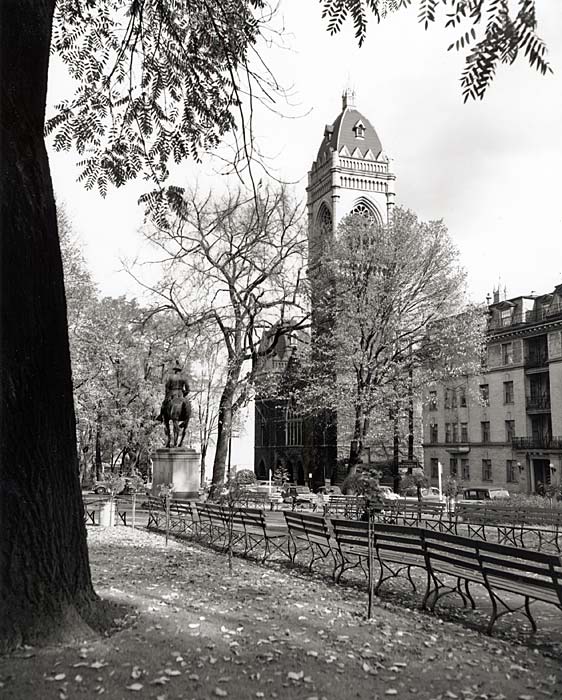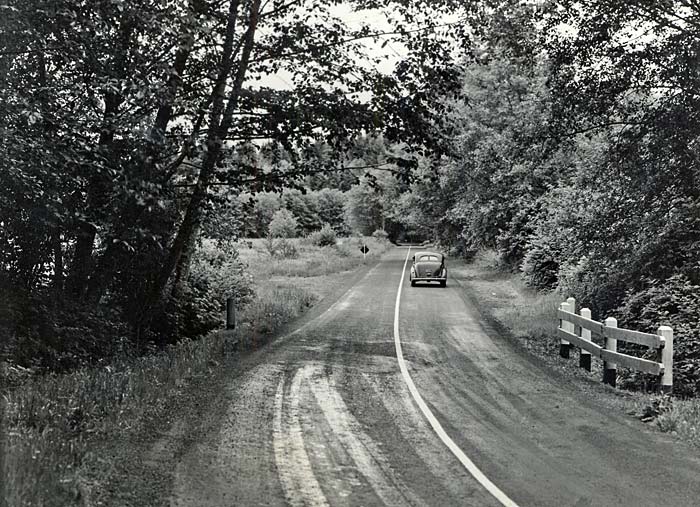 Section map (enlarge image).
Section map (enlarge image).
Section c. Portland to Astoria, 104.5 m.
US 30 leaves PORTLAND, 0 m., on NW. Vaughn St. and St. Helens Road, a part of the Lower Columbia Highway, and passes through a busy industrial district along Portland's lower harbor. Wharves line the Willamette River bank (R) and factories and warehouses occupy the river flats.
The highway passes under the west approach to the ST. JOHNS BRIDGE, 6.5 m., an attractive suspension bridge high above the river.
LINNTON, 7.9 m., a part of Portland since 1915, was founded in the 1840s by Peter H. Burnett, later, first governor of California. He visioned the tiny town as the future metropolis of the Columbia Valley but Portland drew most of the shipping trade and Linnton languished. At present it is an important industrial district of the city; large lumber shipments leave from its wharves.
At 12.7 m. is a junction with the Burlington Ferry approach, a plank viaduct leading to a ferry (free) crossing Willamette Slough.
 A float from The Dalles participates in the Rose Festival Parade (681). Enlarge image.
A float from The Dalles participates in the Rose Festival Parade (681). Enlarge image.
Right on this viaduct to the ferry landing, 0.5 m., off which is SAUVIE ISLAND (850 pop.), which retains much of its pastoral charm. Numerous fishermen and duck hunters frequent the lakes and swales of this popular recreational area. Land of island is quite fertile; bulb culture and truck gardening have become increasingly important in recent years.
Frederic Homer Balch wrote in his Indian romance, The Bridge of the Gods: "The chief of the Willamettes gathered on Wappatto Island, from time immemorial the council ground of the tribes. The white man has changed its name to 'Sauvie' island; but its wonderful beauty is unchangeable. Lying at the mouth of the Willamette River and extending many miles down the Columbia, rich in wide meadows and crystal lakes, its interior dotted with majestic oaks and its shores fringed with cottonwoods, around it the blue and sweeping rivers, the wooded hills, and the far white snow peaks, it is the most picturesque spot in Oregon."
Even though the island has a comparatively small population with neither stores nor shops and but one small sawmill to represent the industrial interests, it is by no means isolated. Many people go there, so many that the small ferry is crowded to capacity. Because of its numerous lakes, ponds and bayous, the island is a popular haunt for duck hunters, and many club houses dot its length. Fishermen seek the shores of the Gilbert River for the crappies, catfish, black and yellow bass, sunfish and perch, that lurk in these sluggish waters. Men grown weary of the turbulence of mountain streams and the elusive antics of the fighting trout, find peace and relaxation in the lazy swirl of the waters and the bobbing of the cork float when a channel cat or crappie takes the bait.
 A view of Portland from Monte Vista Terrace (3943). Enlarge image.
A view of Portland from Monte Vista Terrace (3943). Enlarge image.
The first white men to visit the island as far as known were the Lewis and Clark expedition Nov. 4, 1805. "We landed on the left bank of the river, at a village of twenty five houses; all of these were thatched with straw and built of bark, except one which was about fifty feet long, built of boards ... this village contains about two hundred men of the Skilloot nation, who seemed well provided with canoes, of which there were at least fifty two, and some of them very large, drawn up in front of the village ..." The exploring party stopped a short distance below the village for dinner. "Soon after," Clark recorded, "Several canoes of Indians from the village above came down, dressed for the purpose as I supposed of Paying us a friendly visit, they had scarlet & blue blankets Salor Jackets, overalls, Shirts and hats independent of their usual dress; the most of them had either Muskets or pistols and tin flasks to hold their powder, Those fellows we found assuming and disagreeable, however we Smoked with them and treated them with every attention & friendship."
"... dureing the time we were at dinner those fellows Stold my pipe Tomahawk which they were Smoking with, I immediately serched every man and the canoes, but could find nothing of my Tomahawk, while Serching for the Tomahawk one of those Scoundals Stole a cappoe (coat) of one of our interperters, which was found Stuffed under the root of a tree, near the place they Sat, we became much displeased with those fellows, which they discovered and moved off on their return home to their village."
 The Portland water front looking north from the Market Building (1447). Enlarge image.
The Portland water front looking north from the Market Building (1447). Enlarge image.
In 1832 an epidemic decimated the native population, and Dr. McLoughlin removed the survivors to the mainland and burned many of the straw and board huts of the settlements.
In 1834 Captain Nathanial J. Wyeth built a trading post on the island and named it Fort William. "This Wappato island which I have selected for our establishment," he wrote, "consists of woodland and prairie and on it there is considerable deer and those who could spare time to hunt might live well but mortality has carried off to a man its inhabitants and there is nothing to attest that they ever existed except their decaying houses, their graves and their unburied bones of which there are heaps." Wyeth set his coopers to making barrels to carry salted salmon to Boston. However, his trading activities met with such persistent opposition from the Hudson's Bay Company that in 1836 he was forced to abandon the enterprise.
The hills (L) recede and the highway enters the Scappoose Plains, a fertile district devoted to potato culture, truck gardening, and dairy.
 The Congregational Church on the South Park Blocks in downtown Portland (3213). Enlarge image.
The Congregational Church on the South Park Blocks in downtown Portland (3213). Enlarge image.
SCAPPOOSE (Ind. gravelly plain), 20.9 m. (56 alt., 248 pop.), is on the site of an old trading post and farm of the Hudson's Bay Company, under the charge of Thomas McKay. Chief Kazeno, mentioned in the annals of the Astorians and other later writers, had his village close by. It was here the great Indian highway, later the Hudson's Bay trail between the Columbia River and upper Willamette Valley, had its beginning. When Lieut. W. R. Broughton of the Royal Navy, visited the Columbia River in H. M. S. Chatham of Captain Vancouver's squadron in 1792, he found at Warrior Rock, on Wappato (Sauvie) Island opposite Scappoose, Indians with copper swords and iron battle axes. The Indians said they obtained the axes from the other Indians many moons to the eastward. Scappoose appears to have been a great trading center for Indians on the lower Columbia. The virulent disease which almost wiped out the Indians of the Sauvie Island region began among the Indians at Scappoose Bay and was attributed to "bad medicine" administered by Captain Dominis of the brig Owyhee, which had been trading in the river.
The first white man to settle on Scappoose Plain was James Bates, an American sailor, who probably deserted from the Owyhee in 1829. The town of Scappoose had slow growth and was not incorporated until July 13, 1921. In 1934 fire destroyed several buildings. Today it's a trading center for a prosperous farming community with large potato warehouses and a pickle factory.
MILTON CREEK, 28.5 m., was named for the old town of Milton founded in the late forties at its confluence with Willamette Slough. The Oregon Spectator, in its issue of May 16, 1850, carried the following advertisement: "TOWN OF MILTON is situated on the lower branch of the Willamette River, just above its junction with the Columbia. The advantages of its location speak for themselves. All we ask is for our friends to call and see the place. For particulars apply to Crosby & Smith, Portland and Milton." A few months later the editor of the Spectator wrote: "The town of Milton one mile and a half above St. Helen's is fast improving and may look forward to its future importance ... We are told that the flats or bottom lands which occasionally overflow, are of great extent and produce abundant grass for the grazing of immense flocks and herds, besides offering the opportunity to cut large quantities of hay." A few years later, waters flooded the town and its business was gradually absorbed by nearby St. Helens.
 Terminal No. 1 on Portland water front (3330). Enlarge image.
Terminal No. 1 on Portland water front (3330). Enlarge image.
ST. HELENS, 28.6 m. (98 alt., 3,944 pop.), a river port, is also a market and court town. Its manufacturing plants produce insulating board, pulp and paper, lumber, and dairy products.
The site of St. Helens was first known as Wyeth's Rock for the early trader, Nathaniel Wyeth, who built a temporary post here in 1834. Captain H. M. Knighton took up the site as a donation land claim and in 1847 laid out the town as a competitor of the newly established Portland, which he contemptuously referred to as "Little Stump Town." Knighton named the town both to honor his native city of St. Helens, England, and for the beautiful mountain that rises a few miles to the northeast. According to early records the vicinity was also referred to as Plymouth Rock or Plymouth and the earliest election district established here was named the Plymouth precinct. The earliest school was established in 1853 by the Reverend Thomas Condon, a noted scientist, who later became professor of geology at the University of Oregon. He added to his small salary as pastor of the St. Helens Congregational church by his teaching. The KNIGHTON HOUSE, 155 S. 4th St., was built in 1847 with lumber shipped around Cape Horn from Bath, Maine. Many of the town's buildings, including the COLUMBIA COUNTY COURT HOUSE, at First St. on the river bank, are built of stone from local quarries.
 A road along the lower Columbia River (855). Enlarge image.
A road along the lower Columbia River (855). Enlarge image.
DEER ISLAND, 34.2 m. (48 alt., 75 pop.), is a small community opposite the island of the same name visited in 1805 and again in 1806 by Lewis and Clark. The naming of Deer Island is accounted for in the report of Lewis and Clark: "We left camp at an early hour, and by nine o'clock reached an old Indian village.... Here we found a party of our men whom we had sent on yesterday to hunt, and who now returned after killing seven deer in the course of the morning out of upwards of a hundred which they had seen."
GOBLE, 40.6 m. (25 alt., 91 pop.), is at the former landing of the Northern Pacific Railway Ferry at Kalama, Washington, before the building of the railroad bridge between Vancouver and Portland.
LITTLE JACK FALLS, 43.9 m. (125 alt.), tumbles over a precipice beside the highway.
RAINIER, 47.5 m. (23 alt., 1,353 pop.), named for Mount Rainier, which is often visible to the northeast, was an important stop in the days of river commerce. The town was founded by Charles E. Fox in 1851. First called Eminence, its name was changed to Fox's Landing and finally to Rainier. In 1854 F. M. Warren erected a large steam sawmill and began producing lumber for homes and other buildings of the settlers. Rainier was incorporated in 1885. At Rainier is a toll bridge connecting with Longview, Washington (car and driver, 80c; maximum, $1).